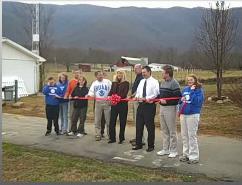On a windy December 9, 2008, a ribbon cutting ceremony was held at the Camp Creek Elementary School in Greenville, Tennessee, to officially open a new NOAA Air Resources Laboratory (ARL) weather monitoring station on the grounds of the school. NOAA scientists from ARL’s Atmospheric Turbulence and Diffusion Division (ATDD), in Oak Ridge, Tennessee, and the National Weather Service’s Weather Forecast Office (WFO) in Morristown, Tennessee, joined the school’s principal and students in cutting the ribbon. The ceremony took place outside, while wind speeds exceeded 35 mph and gusts hit nearly 65 mph in the immediate area.

In mid November, the ATDD installed a meteorological monitoring station at the Camp Creek Elementary School in cooperation with the Morristown WFO. The weather tower, which includes two different types of wind-speed measuring devices, is designed to provide forecasting support for strong winds generated from a meteorological phenomenon called “mountain waves”. Mountain waves produce strong winds (up to 100 mph) in the foothills of the southern Appalachian Mountains (as well as worldwide) and frequently occur from the period November through March. When these events occur, the Camp Creek area sustains significant property damage and the school’s operations are affected. The station is in an optimal location on the school property with an unobstructed path from the mountains.
In addition to high winds in the foothills, foehn (adiabatic) warming typically occurs with mountain wave events downwind of the mountains in the valley (also known as Chinook winds or Santa Ana winds). A unique feature of foehn winds in the Camp Creek area is that the dew point typically rises. In other areas of the world, foehn winds are dry winds.
NOAA scientists have long known about the winds in this region, but they have not been well documented. The new weather monitoring equipment at Camp Creek will, for the first time, measure the mountain waves as they occur, shedding more light for researchers on this phenomenon. Also, wind speed data from the new equipment can be accessed through the internet, allowing school official and teachers to assess when high winds are most likely to occur.

